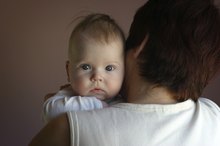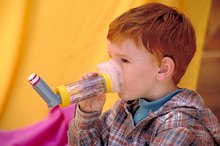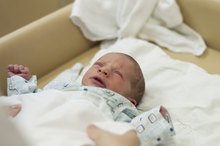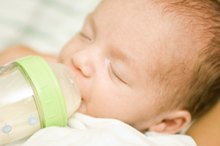Infant Seizures Signs & Symptoms
A seizure is a characteristic symptom of epilepsy and may be caused by birth defects, problems during pregnancy or delivery, illness, fevers, infections and poisons in the body. According to the University of Maryland Medical Center or UMMC, also notes that some infants may experience seizures due to brain and nervous system disorders such as hydrocephalus or fluid buildup in the brain. Seizures in infants due to epilepsy will occur more than once, while seizures due to fevers and other reasons are usually isolated. A pediatrician can determine if an infant is suffering seizures due to epilepsy.
Repetitive Motions
Neonatal onset epilepsy causes seizures in infants under the age of two months, as explained by the EpilepsyFoundation.org. This type of seizure involves repetitive motions symptoms such as sucking, blinking and fluttering the eyelids, tongue extending, lip smacking and pauses in breathing. Other repetitive motions that indicate a seizure in infants include paddling or wrist-waving motions of the hands and pedaling movements of the legs and feet.
Muscle Spasms
Symptoms of Tourette's in Babies
Learn More
The EpilepsyFoundation.org notes that infantile onset epilepsy seizures occur in infants that are approximately one to two years old. These seizures have symptoms of sudden and jerking muscles contractions or spasms that usually occur early in the morning while the baby is sleeping or when the infant is waking from a nap. These muscle contractions may last for up to a few seconds each and occur in clusters that affect the head, neck, legs, trunk and arms. The muscles contractions may be so small and subtle that may not be immediately noticeable but will cause the baby to cry suddenly and excessively.
- The EpilepsyFoundation.org notes that infantile onset epilepsy seizures occur in infants that are approximately one to two years old.
- These seizures have symptoms of sudden and jerking muscles contractions or spasms that usually occur early in the morning while the baby is sleeping or when the infant is waking from a nap.
Loss of Consciousness
Grand mal or severe and dramatic seizures can occur in babies over two months of age. These types of seizures can result in a loss of consciousness as the infant stops breathing temporarily. The baby’s lips may also turn blue from a lack of oxygen. These symptoms can be very frightening for parents.
- Grand mal or severe and dramatic seizures can occur in babies over two months of age.
- These types of seizures can result in a loss of consciousness as the infant stops breathing temporarily.
Muscle Stiffness
Albuterol Side Effects in Toddlers
Learn More
Grand mal seizures and febrile seizures in infants, which occur due to high fevers can cause stiffening or paralysis of the muscles, as noted by the Mayo Clinic. The National Institute of Neurological Disorders and Stroke explains that body stiffening symptoms usually last for approximately five minutes and include fixed staring, muscle rigidity or limpness and loss of muscle tone.
Related Articles
References
- EpilepsyFoundation.org: Neonatal Onset
- MayoClinic.com: Fever
- EpilepsyFoundation.org: Infantile Onset
- KiriakopoulosE, Shafer PO. Types of Seizures. Epilepsy Foundation. Published March 20, 2017. https://www.epilepsy.com/learn/types-seizures
- Mayo Clinic Staff. Epilepsy. Mayo Clinic. Updated March 10, 2018. https://www.mayoclinic.org/diseases-conditions/epilepsy/symptoms-causes/syc-20350093
- Mayo Clinic Staff. Epilepsy and Pregnancy: What You Need to Know. Mayo Clinic. Updated July 13, 2017. https://www.mayoclinic.org/healthy-lifestyle/pregnancy-week-by-week/in-depth/pregnancy/art-20048417
- National Institute of Neurological Disorders and Stroke. The Epilepsies and Seizures: Hope Through Research: Pregnancy and Motherhood. NationalInstitutes of Health. Updated December 6, 2017. https://www.ninds.nih.gov/Disorders/Patient-Caregiver-Education/Hope-Through-Research/Epilepsies-and-Seizures-Hope-Through#3109_38
- Bromfield EB, Cavazos JE, Sirven JI. Clinical Epilepsy. In: An Introduction to Epilepsy [Internet]. West Hartford, CT: American Epilepsy Society; 2006.
- Xu MY. Poststroke seizure: optimising its management. Stroke Vasc Neurol. 2019;4(1):48-56. doi:10.1136/svn-2018-000175
- Blair RD. Temporal lobe epilepsy semiology. Epilepsy Res Treat. 2012;2012:751510. doi:10.1155/2012/751510
- Mirzadjanova Z, Peters AS, Rémi J, Bilgin C, Silva cunha JP, Noachtar S. Significance of lateralization of upper limb automatisms in temporal lobe epilepsy: a quantitative movement analysis. Epilepsia. 2010;51(10):2140-6. doi:10.1111/j.1528-1167.2010.02599.x
- Spencer D. Auras Are Frequent in Patients With Generalized Epilepsy. Epilepsy Curr. 2015;15(2):75-7. doi:10.5698/1535-7597-15.2.75
- Gossman WI, Albuja AC, Murphy PB. Absence Seizure. Treasure Island, FL: StatPearls Publishing; 2019.
- Lanigar S, Bandyopadhyay S. Sleep and Epilepsy: A Complex Interplay. Mo Med. 2017;114(6):453-457.
- Kiriakopoulos E. Atonic Seizures. Epilepsy Foundation. Mar 18, 2017.
- Devinsky O. Myoclonic Seizures. Epilepsy Foundation. PJul 2013.
- Kiriakopoulos E. Clonic Seizures. Epilepsy Foundation. Mar 2017.
- Pal BC, Kumar S, Dorairajan LN, Khattar N. Generalized seizure: A rare etiology of intraperitoneal rupture of the urinary bladder. Indian J Urol. 2007;23(4):467-8. doi:10.4103/0970-1591.36723
- Nguyen R, Téllez zenteno JF. Injuries in epilepsy: a review of its prevalence, risk factors, type of injuries and prevention. Neurol Int. 2009;1(1):e20. doi:10.4081/ni.2009.e20
- Cherian A, Thomas SV. Status epilepticus. Ann Indian Acad Neurol. 2009;12(3):140-53. doi:10.4103/0972-2327.56312
- SUDEP. Epilepsy Foundation. Published August 2013.
- Velísková J, De jesus G, Kaur R, Velísek L. Females, their estrogens, and seizures. Epilepsia. 2010;51 Suppl 3:141-4. doi:10.1111/j.1528-1167.2010.02629.x
- Reimers A. Contraception for women with epilepsy: counseling, choices, and concerns. Open Access J Contracept. 2016;7:69-76. doi:10.2147/OAJC.S85541
- Patel SI, Pennell PB. Management of epilepsy during pregnancy: an update. Ther Adv Neurol Disord. 2016;9(2):118-29. doi:10.1177/1756285615623934
- KiriakopoulosE, Shafer PO. Types of Seizures. Epilepsy Foundation. Published March 20, 2017.
- Mayo Clinic Staff. Epilepsy. Mayo Clinic. Updated March 10, 2018.
- Mayo Clinic Staff. Epilepsy and Pregnancy: What You Need to Know. Mayo Clinic. Updated July 13, 2017.
- National Institute of Neurological Disorders and Stroke. The Epilepsies and Seizures: Hope Through Research: Pregnancy and Motherhood. NationalInstitutes of Health. Updated December 6, 2017.
Writer Bio
Noreen Kassem is a hospital doctor and a medical writer. Her articles have been featured in "Women's Health," "Nutrition News," "Check Up" and "Alive Magazine." Kassem also covers travel, books, fitness, nutrition, cooking and green living.








